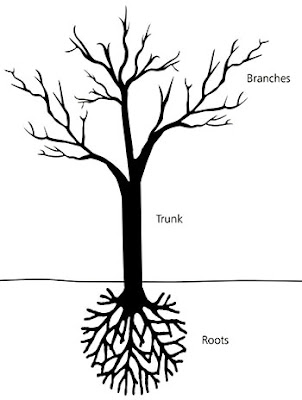 |
| I found this outline drawing of a tree with its roots to demonstrate Bill's model. |
When Alma taught the Zoramites, he spoke of planting a small seed. This seed was the Word of God, the Savior and His gospel. He used the seed metaphor to describe the development of faith, beginning with no more than a desire to believe, and growing into a mighty tree of faith and testimony. Today, I'd like to use these same images to describe, not eternal progress, but eternal regress. I'm talking about the development of sin.
Where does the process of sinning begin? With the sin itself? No. It is much earlier. Just as with the planting of faith, sin begins with the planting of one tiny seed - a single thought. The individual encounters a tempting situation and thinks, "What if . . . ?" If that thought is recognized and weeded out immediately and replaced with a more uplifting thought, the crisis is averted. The seed never germinates. Picture a small seed, almost invisible under the root system of the tree in the illustration. It is as true today as it was when the Proverb was written, As a man thinketh in his heart, so is he. (Proverbs 23: 7)
If, however, the person allows the thought to remain, even beginning to contemplate the thought, the seed germinates and begins to put out tenuous roots. As the person ponders the temptation, he may well think of the possible negative consequences of following through with it. At that point in time, another small thought often appears: "It won't happen to me." The root system grows and the seed begins to sprout small leaves. This is still invisible because it is sprouting under the soil where it cannot be seen.
While the sprouting is invisible to others, the individual knows and God knows. However, as the plant pushes above the ground, it can become visible. The person begins to develop an attitude around the temptation, usually involving a lot of self-delusion. But attitude, as it grows, becomes visible to others, particularly others who know the person well, like close friends, family, or Church leaders. If these loving people confront the person at this point, they will often be greeted with denial and rationalization. Many people choose not to confront for fear of this response.
As attitude grows, the person will ultimately decide to do it - whatever it is. If the result of the act is painful or unpleasant, the person may choose not to repeat the action. If, however, the experience has pleasurable results, the likelihood of repetition is strong. Satan is the master of creating pleasure in the moment, but not happiness in the long run. Others may not know what he did at first, but if the behavior continues and the seedling grows, eventually others will notice.
Other behavior may develop around the initial sin - lying, stealing, promiscuity - even violence. The trunk of the tree becomes thicker and much stronger. Repeat these behaviors often enough, they become habits. By then the Spirit has been so silenced within the sinner that he continues, perhaps telling himself, "I don't have a problem. I can quit any time."
Imagine a line drawn across the trunk. This is the invisible line between habit and addiction. The person rarely sees the line before he has crossed it, and once crossed, it is almost impossible to turn back by himself. By then, the sinner has, little-by-little, given his precious agency over to someone or something that is not God. Satan cannot force a person to relinquish his agency; but if the person volutarily surrenders that agency, Satan will not let him go easily.
As the trunk of the tree thickens and branches begin to grow, there are no happy endings to this scenario. In the case of addictions, there are certain predictable outcomes: loss of precious relationships, loss of the Spirit, physical, mental, and spiritual illness, even legal problems, including incarceration in some case. Ultimately, if not treated, the final scenario is death - physical and spiritual. Paul taught the Romans that the wages of sin is death. . . (Romans 6:23)
But there is always hope. While sin leads inevitably to misery and death, Paul gives comfort by finishing his message in verse 23 with these words: . . . the gift of God is eternal life through Jesus Christ our Lord.
That is the good news. Jesus is our Salvation here on earth as well as in the eternities. Most of us are not strong enough to break Satan's grip by ourselves, but Jesus Christ can free us if we turn to Him. The sooner we catch ourselves climbing the tree of sin, the better. Most addiction recovery programs are built on the 12-step. I think everyone should come to understand those steps for they are the steps of repentance, the way out of sin and hell, the way back to our Heavenly Father. Jesus Christ is the Way, the Truth, and the Life. In truth, He is the only way.
© March 2020 Dr. Kathleen Rawlings
Buntin Danielson
* Bill Oliver, Parent-to-Parent, Atlanta, Georgia







No comments:
Post a Comment